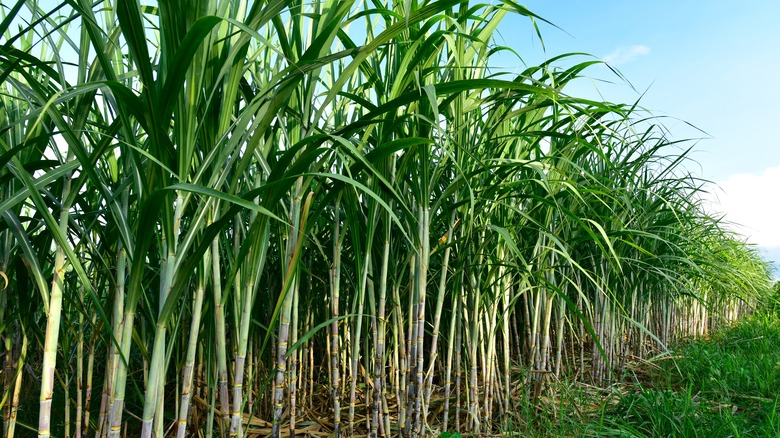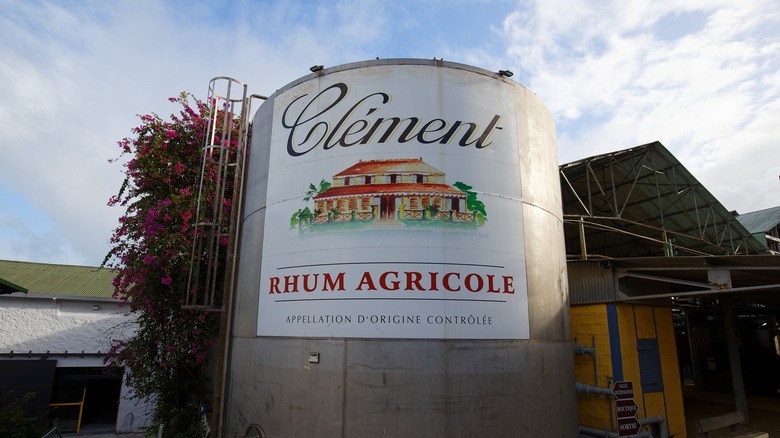What's The Difference Between Rum And Rhum?
Rum is one of the world's most diverse spirits. Ranging from 20 percent ABV to 75.5, the liquor encompasses varieties that can be aged or white, dark, spiced, and just about everything in between. Some styles make for a great sipper, others a component in a bright and fruity tropical punch, notes Vinepair.
And while a large part of it is produced in large volumes, like in Puerto Rico, there are also numerous small-batch producers. Especially in the French Caribbean, like the islands of Martinique and Guadlupe, there are a multitude of producers manually harvesting sugarcane, using mules to fertilize, and producing less than a thousand bottles a year, per Caribbean Journal.
Frequently, they label their resultant spirit rhum agricole, or "agricultural rum" in French, according to Bon Appetit. So when there's a bottle on the shelf with that extra letter, it begs investigation — rhum vs rum, what's the difference?
Rum is abroad encompassing term for a variety of sugarcane based spirits
As defined by the U.S. Government's Code of Federal Regulations, rum is any spirit of at least 80 proof that's distilled from "sugar cane, sugar cane syrup, sugar cane molasses, or other sugar cane by-products."
Produced in at least 80 countries, rum is not intertwined with a specific region or processing technique. Instead, the spirit boasts an extensive assortment of regional preparations. Such a loose definition combined with a multitude of producers means there are a whole lot of flavors, colors, and styles — from white, spiced to aged. As a result, categorization is tricky, not only due to the range but also varying definitions by country, notes Fine Wine ABC & Spirits.
Rhum Agricole, often shorted to simply rhum, is precisely such a subcategorization — a specified variant of rum. Made with a specific fermentation method, the spirit is interlinked with the French Caribbean, specifically the islands of Martinique, Haiti, and Guadeloupe. However, it isn't bound by a regional definition — the spirit is also produced in the Dominican Republic and the Indian Ocean. Past its strong affiliation with France, the rhum agricole has a unique production process that lends it a characteristic flavor, via World Rum Guide. Let's dive into the specifics.
Rhum agricole is a type of rum made from fresh sugarcane
Unlike most rums, which start with a fermented molasses base, rhum is fermented from fresh sugarcane. The juice is first inoculated with wild local yeasts, producing a wine-like beverage that is then distilled. The result is a vibrant, grassy spirit with strong funk and floral flavor, according to Thrillist. Rhum agricole's distinct taste is distinguishable due to the fermenting base.
When molasses ferments, it yields the caramel, syrupy flavors characteristic of most rums. However, the fermentation of fresh sugarcane transmits the aromas of the grass, in turn showcasing its origins. Only if rhum agricole is aged, then the barrel's character overshadows, and the rum tastes similar to other varieties, notes Punch.
According to Fine + Rare, molasses is a fairly standard product — what distinguishes most producers of rum is the distillation and aging process. However, the fermentation of fresh sugarcane transmits terroir from plant to resultant glass. Not only is rhum typically unaged, but fresh sugarcane juice is a volatile liquid that starts fermenting immediately. Therefore, most rhum agricole is produced from start to finish on one premise, unlike other rum production. The result is a bright, strongly flavored spirit reflective of its raw materials and origins.


